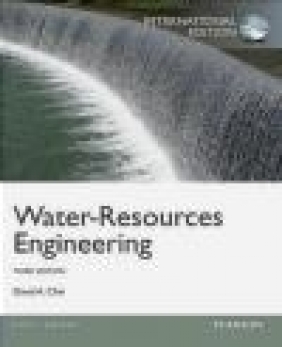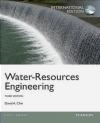Water-Resources Engineering
David A. Chin
Water-Resources Engineering
David A. Chin
- Producent: Pearson
- Rok produkcji: 2013
- ISBN: 9780273785910
- Ilość stron: 960
- Oprawa: Miękka
Niedostępna
Opis: Water-Resources Engineering - David A. Chin
For a senior- or graduate-level first course in water-resources engineering offered in civil and environmental engineering degree programs. A prerequisite course in fluid mechanics and calculus up to differential equations is assumed. Water-Resources Engineering provides comprehensive coverage of hydraulics, hydrology, and water-resources planning and management. Presented from first principles, the material is rigorous, relevant to the practice of water resources engineering, and reinforced by detailed presentations of design applications.Preface xv 1 Introduction 1 1.1 Water-Resources Engineering ... 1 1.2 The Hydrologic Cycle ... 1 1.3 Design of Water-Resource Systems ... 5 1.3.1 Water-Control Systems ... 5 1.3.2 Water-Use Systems ... 6 1.3.3 Supporting Federal Agencies in the United States ... 7 Problem... 8 2 Fundamentals of Flow in Closed Conduits 9 2.1 Introduction ... 9 2.2 Single Pipelines ... 9 2.2.1 Steady-State Continuity Equation ... 9 2.2.2 Steady-State Momentum Equation ... 10 2.2.3 Steady-State Energy Equation ... 22 2.2.3.1 Energy and hydraulic grade lines ... 25 2.2.3.2 Velocity profile ... 27 2.2.3.3 Head losses in transitions and fittings ... 27 2.2.3.4 Head losses in non circular conduits ... 31 2.2.3.5 Empirical friction-loss formulae ... 32 2.2.4 Water Hammer ... 35 2.3 Pipe Networks ... 39 2.3.1 Nodal Method ... 40 2.3.2 Loop Method ... 42 2.3.3 Application of Computer Programs ... 46 2.4 Pumps ... 46 2.4.1 Affinity Laws ... 51 2.4.2 Pump Selection ... 53 2.4.2.1 Commercially available pumps ... 53 2.4.2.2 System characteristics ... 54 2.4.2.3 Limits on pump location ... 55 2.4.3 Multiple-Pump Systems ... 58 2.4.4 Variable-Speed Pumps ... 60 Problems ... 62 3 Design of Water-Distribution Systems 70 3.1 Introduction ... 70 3.2 Water Demand ... 70 3.2.1 Per-Capita Forecast Model ... 71 3.2.1.1 Estimation of per-capita demand ... 71 3.2.1.2 Estimation of population ... 72 3.2.2 Temporal Variations in Water Demand ... 76 3.2.3 Fire Demand ... 77 3.2.4 Design Flows ... 79 3.3 Components of Water-Distribution Systems ... 81 3.3.1 Pipelines ... 81 3.3.1.1 Minimum size ... 82 3.3.1.2 Service lines ... 83 3.3.1.3 Pipe materials ... 83 3.3.2 Pumps ... 85 3.3.3 Valves ... 85 3.3.4 Meters ... 85 3.3.5 Fire Hydrants ... 86 3.3.6 Water-Storage Reservoirs ... 87 3.4 Performance Criteria for Water-Distribution Systems ... 90 3.4.1 Service Pressures ... 91 3.4.2 Allowable Velocities ... 91 3.4.3 Water Quality ... 91 3.4.4 Network Analysis ... 92 3.5 Building Water-Supply Systems ... 93 3.5.1 Specification of Design Flows ... 94 3.5.2 Specification of Minimum Pressures ... 94 3.5.3 Determination of Pipe Diameters ... 96 Problems ... 101 4 Fundamentals of Flow in Open Channels 103 4.1 Introduction ... 103 4.2 Basic Principles ... 103 4.2.1 Steady-State Continuity Equation ... 103 4.2.2 Steady-State Momentum Equation ... 104 4.2.2.1 Darcy-Weisbach equation ... 106 4.2.2.2 Manning equation ... 110 4.2.2.3 Other equations ... 119 4.2.2.4 Velocity distribution ... 120 4.2.3 Steady-State Energy Equation ... 121 4.2.3.1 Energy grade line ... 125 4.2.3.2 Specific energy ... 125 4.3 Water-Surface Profiles ... 132 4.3.1 Profile Equation ... 132 4.3.2 Classification of Water-Surface Profiles ... 134 4.3.3 Hydraulic Jump ... 139 4.3.4 Computation of Water-Surface Profiles ... 143 4.3.4.1 Direct-integration method ... 145 4.3.4.2 Direct-step method ... 147 4.3.4.3 Standard-step method ... 148 4.3.4.4 Practical considerations ... 150 4.3.4.5 Profiles across bridges ... 154 Problems ... 159 5 Design of Drainage Channels 166 5.1 Introduction ... 166 5.2 Basic Principles ... 167 5.2.1 Best Hydraulic Section ... 167 5.2.2 Boundary Shear Stress ... 170 5.2.3 Cohesive versus Non cohesive Materials ... 172 5.2.4 Bends ... 177 5.2.5 Channel Slopes ... 178 5.2.6 Freeboard ... 178 5.3 Design of Channels with Rigid Linings ... 180 5.4 Design of Channels with Flexible Linings ... 182 5.4.1 General Design Procedure ... 183 5.4.2 Vegetative Linings and Bare Soil ... 187 5.4.3 RECP Linings ... 197 5.4.4 Riprap, Cobble, and Gravel Linings ... 199 5.4.5 Gabions ... 203 5.5 Composite Linings ... 205 Problems ... 208 6 Design of Sanitary Sewers 211 6.1 Introduction ... 211 6.2 Quantity of Wastewater ... 211 6.2.1 Residential Sources ... 211 6.2.2 Nonresidential Sources ... 212 6.2.3 Inflow and Infiltration (I/I) ... 213 6.2.4 Peaking Factors ... 214 6.3 Hydraulics of Sewers ... 216 6.3.1 Manning Equation with Constant n ... 218 6.3.2 Manning Equation with Variable n ... 220 6.3.3 Self-Cleansing ... 223 6.3.4 Scour Prevention ... 224 6.3.5 Design Computations for Diameter and Slope ... 224 6.3.6 Hydraulics of Manholes ... 227 6.4 System Design Criteria ... 229 6.4.1 System Layout ... 229 6.4.2 Pipe Material ... 229 6.4.3 Depth of Sanitary Sewer ... 231 6.4.4 Diameter and Slope of Pipes ... 231 6.4.5 Hydraulic Criteria ... 231 6.4.6 Manholes ... 231 6.4.7 Pump Stations ... 233 6.4.8 Force Mains ... 233 6.4.9 Hydrogen-Sulfide Control ... 234 6.4.10 Combined Sewers ... 236 6.5 Design Computations ... 236 6.5.1 Design Aids ... 237 6.5.1.1 Manning's n ... 237 6.5.1.2 Minimum slope for self-cleansing ... 237 6.5.2 Procedure for System Design ... 240 Problems ... 247 7 Design of Hydraulic Structures 250 7.1 Introduction ... 250 7.2 Culverts ... 250 7.2.1 Hydraulics ... 250 7.2.1.1 Submerged entrances ... 252 7.2.1.2 Unsubmerged entrances ... 259 7.2.2 Design Constraints ... 262 7.2.3 Sizing Calculations ... 264 7.2.3.1 Fixed-headwater method ... 265 7.2.3.2 Fixed-flow method ... 269 7.2.3.3 Minimum-performance method ... 271 7.2.4 Roadway Overtopping ... 271 7.2.5 Riprap/Outlet Protection ... 274 7.3 Gates ... 275 7.3.1 Free Discharge ... 276 7.3.2 Submerged Discharge ... 279 7.3.3 Empirical Equations ... 281 7.4 Weirs ... 282 7.4.1 Sharp-Crested Weirs ... 282 7.4.1.1 Rectangular weirs ... 282 7.4.1.2 V-notch weirs ... 288 7.4.1.3 Compound weirs ... 291 7.4.1.4 Other types of sharp-crested weirs ... 293 7.4.2 Broad-Crested Weirs ... 294 7.4.2.1 Rectangular weirs ... 294 7.4.2.2 Compound weirs ... 297 7.4.2.3 Gabion weirs ... 298 7.5 Spillways ... 299 7.5.1 Uncontrolled Spillways ... 299 7.5.2 Controlled (Gated) Spillways ... 307 7.5.2.1 Gates seated on the spillway crest ... 308 7.5.2.2 Gates seated downstream of the spillway crest ... 309 7.6 Stilling Basins ... 312 7.6.1 Type Selection ... 312 7.6.2 Design Procedure ... 314 7.7 Dams and Reservoirs ... 318 7.7.1 Types of Dams ... 319 7.7.2 Reservoir Storage ... 322 7.7.2.1 Sediment accumulation ... 323 7.7.2.2 Determination of storage requirements ... 326 7.7.3 Hydropower ... 328 7.7.3.1 Turbines ... 328 7.7.3.2 Turbine performance ... 333 7.7.3.3 Feasibility of hydropower ... 334 Problems ... 335 8 Probability and Statistics in Water-Resources Engineering 344 8.1 Introduction ... 344 8.2 Probability Distributions ... 345 8.2.1 Discrete Probability Distributions ... 345 8.2.2 Continuous Probability Distributions ... 346 8.2.3 Mathematical Expectation and Moments ... 347 8.2.4 Return Period ... 350 8.2.5 Common Probability Functions ... 351 8.2.5.1 Binomial distribution ... 351 8.2.5.2 Geometric distribution ... 353 8.2.5.3 Poisson distribution ... 354 8.2.5.4 Exponential distribution ... 356 8.2.5.5 Gamma/Pearson Type III distribution ... 357 8.2.5.6 Normal distribution ... 360 8.2.5.7 Log-normal distribution ... 362 8.2.5.8 Uniform distribution ... 363 8.2.5.9 Extreme-value distributions ... 364 8.2.5.10 Chi-square distribution ... 371 8.3 Analysis of Hydrologic Data ... 372 8.3.1 Estimation of Population Distribution ... 372 8.3.1.1 Probability distribution of observed data ... 372 8.3.1.2 Hypothesis tests ... 376 8.3.1.3 Model selection criteria ... 379 8.3.2 Estimation of Population Parameters ... 379 8.3.2.1 Method of moments ... 379 8.3.2.2 Maximum-likelihood method ... 382 8.3.2.3 Method of L-moments ... 383 8.3.3 Frequency Analysis ... 387 8.3.3.1 Normal distribution ... 388 8.3.3.2 Log-normal distribution ... 389 8.3.3.3 Gamma/Pearson Type III distribution ... 390 8.3.3.4 Log-Pearson Type III distribution ... 391 8.3.3.5 Extreme-value Type I distribution ... 393 8.3.3.6 General extreme-value (GEV) distribution ... 394 8.4 Uncertainty Analysis ... 395 Problems ... 397 9 Fundamentals of Surface-Water Hydrology I: Rainfall and Abstractions 401 9.1 Introduction ... 401 9.2 Rainfall ... 401 9.2.1 Measurement of Rainfall ... 403 9.2.2 Statistics of Rainfall Data ... 405 9.2.2.1 Rainfall statistics in the United States ... 410 9.2.2.2 Secondary estimation of IDF curves ... 410 9.2.3 Spatial Averaging and Interpolation of Rainfall ... 416 9.2.4 Design Rainfall ... 421 9.2.4.1 Return period ... 421 9.2.4.2 Rainfall duration ... 422 9.2.4.3 Rainfall depth ... 422 9.2.4.4 Temporal distribution ... 422 9.2.4.5 Spatial distribution ... 428 9.2.5 Extreme Rainfall ... 429 9.2.5.1 Rational estimation method ... 430 9.2.5.2 Statistical estimation method ... 430 9.2.5.3 World-record precipitation amounts ... 432 9.2.5.4 Probable maximum storm ... 432 9.3 Rainfall Abstractions ... 433 9.3.1 Interception ... 433 9.3.2 Depression Storage ... 437 9.3.3 Infiltration ... 437 9.3.3.1 The infiltration process ... 439 9.3.3.2 Horton model ... 442 9.3.3.3 Green-Ampt model ... 447 9.3.3.4 NRCS curve-number model ... 453 9.3.3.5 Comparison of infiltration models ... 460 9.3.4 Rainfall Excess on Composite Areas ... 461 9.4 Baseflow ... 464 Problems ... 468 10 Fundamentals of Surface-Water Hydrology II: Runoff 473 10.1 Introduction ... 473 10.2 Mechanisms of Surface Runoff ... 473 10.3 Time of Concentration ... 474 10.3.1 Overland Flow ... 474 10.3.1.1 Kinematic-wave equation ... 474 10.3.1.2 NRCS method ... 478 10.3.1.3 Kirpich equation ... 481 10.3.1.4 Izzard equation ... 481 10.3.1.5 Kerby equation ... 482 10.3.2 Channel Flow ... 484 10.3.3 Accuracy of Estimates ... 486 10.4 Peak-Runoff Models ... 487 10.4.1 The Rational Method ... 487 10.4.2 NRCS-TR55 Method ... 492 10.5 Continuous-Runoff Models ... 495 10.5.1 Unit-Hydrograph Theory ... 495 10.5.2 Instantaneous Unit Hydrograph ... 501 10.5.3 Unit-Hydrograph Models ... 502 10.5.3.1 Snyder unit-hydrograph model ... 503 10.5.3.2 NRCS dimensionless unit hydrograph ... 506 10.5.3.3 Accuracy of unit-hydrograph models ... 509 10.5.4 Time-Area Models ... 509 10.5.5 Kinematic-Wave Model ... 514 10.5.6 Nonlinear-Reservoir Model ... 515 10.5.7 Santa Barbara Urban Hydrograph Model ... 517 10.5.8 Extreme Runoff Events ... 519 10.6 Routing Models ... 520 10.6.1 Hydrologic Routing ... 520 10.6.1.1 Modified Pulsmethod ... 520 10.6.1.2 Muskingum method ... 524 10.6.2 Hydraulic Routing ... 531 10.7 Water-Quality Models ... 533 10.7.1 Event-Mean Concentrations ... 533 10.7.2 Regression Equations ... 535 10.7.2.1 USGS model ... 535 10.7.2.2 EPA model ... 537 Problems ... 539 11 Design of Stormwater-Collection Systems 545 11.1 Introduction ... 545 11.2 Street Gutters ... 545 11.3 Inlets ... 549 11.3.1 Curb Inlets ... 550 11.3.2 Grate Inlets ... 554 11.3.3 Combination Inlets ... 560 11.3.4 Slotted Inlets ... 565 11.4 Roadside and Median Channels ... 566 11.5 Storm Sewers ... 567 11.5.1 Calculation of Design Flow Rates ... 568 11.5.2 Pipe Sizing and Selection ... 571 11.5.3 Manholes ... 576 11.5.4 Determination of Impervious Area ... 577 11.5.5 System-Design Computations ... 578 11.5.6 Other Design Considerations ... 583 Problems ... 584 12 Design of Stormwater-Management Systems 586 12.1 Introduction ... 586 12.2 Performance Goals ... 586 12.2.1 Quantity Control ... 586 12.2.2 Quality Control ... 586 12.3 Design of Stormwater Control Measures ... 587 12.3.1 Storage Impoundments ... 587 12.3.1.1 Detention basins-Design parameters ... 588 12.3.1.2 Wet detention basins ... 590 12.3.1.3 Dry detention basins ... 592 12.3.1.4 Design of outlet structures ... 593 12.3.1.5 Design for flood control ... 599 12.3.2 Infiltration Basins ... 603 12.3.3 Swales ... 605 12.3.3.1 Retention wales ... 606 12.3.3.2 Biofiltration swales ... 607 12.3.4 Vegetated Filter Strips ... 610 12.3.5 Bioretention Systems ... 610 12.3.6 Exfiltration Trenches ... 612 12.3.6.1 General design guidelines ... 613 12.3.6.2 Design for flood control ... 614 12.3.6.3 Design fo rwater-quality control ... 616 12.3.7 Subsurface Exfiltration Galleries ... 617 12.4 Selection of SCMs for Water-Quality Control ... 618 12.4.1 Nonstructura lSCMs ... 618 12.4.2 Structural SCMs ... 618 12.4.3 Other Considerations ... 619 12.5 Major Drainage System ... 619 Problems ... 619 13 Estimation of Evapotranspiration 624 13.1 Introduction ... 624 13.2 Penman-Monteith Equation ... 624 13.2.1 Aerodynamic Resistance ... 625 13.2.2 Surface Resistance ... 626 13.2.3 Net Radiation ... 627 13.2.3.1 Shortwave radiation ... 627 13.2.3.2 Longwave radiation ... 629 13.2.4 Soil Heat Flux ... 630 13.2.5 Latent Heat of Vaporization ... 631 13.2.6 Psychrometric Constant ... 631 13.2.7 Saturation Vapor Pressure ... 632 13.2.8 Vapor-Pressure Gradient ... 632 13.2.9 Actual Vapor Pressure ... 632 13.2.10 Air Density ... 633 13.3 Application of the PM Equation ... 634 13.4 Potential Evapotranspiration ... 637 13.5 Reference Evapotranspiration ... 638 13.5.1 FAO56-Penman-Monteith Method ... 639 13.5.2 ASCE Penman-Monteith Method ... 643 13.5.3 Evaporation Pans ... 644 13.5.4 Empirical Methods ... 648 13.6 Actual Evapotranspiration ... 651 13.6.1 Index-of-Dryness Method ... 651 13.6.2 Crop-Coefficient Method ... 653 13.6.3 Remote Sensing ... 653 13.7 Selection of ET Estimation Method ... 654 Problems ... 654 14 Fundamentals of Groundwater Hydrology I: Governing Equations 656 14.1 Introduction ... 656 14.2 Darcy's Law ... 662 14.2.1 Hydraulic Conductivity ... 666 14.2.1.1 Empirical formulae ... 666 14.2.1.2 Classification ... 670 14.2.1.3 Anisotropic properties ... 670 14.2.1.4 Stochastic properties ... 674 14.3 General Flow Equation ... 676 14.4 Two-Dimensional Approximations ... 681 14.4.1 Unconfined Aquifers ... 681 14.4.2 Confined Aquifers ... 687 14.5 Flow in the Unsaturated Zone Problems ... 691 Problems ... 696 15 Fundamentals of Groundwater Hydrology II: Applications 700 15.1 Introduction ... 700 15.2 Steady-State Solutions ... 700 15.2.1 Unconfined Flow Between Two Reservoirs ... 700 15.2.2 Well in a Confined Aquifer ... 702 15.2.3 Well in an Unconfined Aquifer ... 706 15.2.4 Well in a Leaky Confined Aquifer ... 709 15.2.5 Well in an Unconfined Aquifer with Recharge ... 713 15.2.6 Partially Penetrating Wells ... 714 15.3 Unsteady-State Solutions ... 718 15.3.1 Well in a Confined Aquifer ... 718 15.3.2 Well in an Unconfined Aquifer ... 728 15.3.3 Well in a Leaky Confined Aquifer ... 736 15.3.4 Other Solutions ... 741 15.4 Principle of Superposition ... 741 15.4.1 Multiple Wells ... 742 15.4.2 Well in Uniform Flow ... 744 15.5 Method of Images ... 746 15.5.1 Constant-Head Boundary ... 746 15.5.2 Impermeable Boundary ... 750 15.5.3 Other Applications ... 752 15.6 Saltwater Intrusion ... 752 Problems ... 761 16 Design of Groundwater Systems 771 16.1 Introduction ... 771 16.2 Design of Wellfields ... 771 16.3 Wellhead Protection ... 774 16.3.1 Delineation of Wellhead Protection Areas ... 774 16.3.2 Time-of-Travel Approach ... 775 16.4 Design and Construction of Water-Supply Wells ... 777 16.4.1 Types of Wells ... 777 16.4.2 Design of Well Components ... 778 16.4.2.1 Casing ... 779 16.4.2.2 Screen intake ... 779 16.4.2.3 Gravel pack ... 783 16.4.2.4 Pump ... 784 16.4.2.5 Other considerations ... 785 16.4.3 Performance Assessment ... 788 16.4.4 Well Drilling ... 793 16.5 Design of Aquifer Pumping Tests ... 794 16.5.1 Pumping Well ... 794 16.5.2 Observation Wells ... 795 16.5.3 Field Procedures ... 796 16.6 Design of Slug Tests ... 798 16.7 Design of Exfiltration Trenches ... 803 16.8 Seepage Meters ... 808 Problems ... 809 17 Water-Resources Planning 815 17.1 Introduction ... 815 17.2 Planning Process ... 815 17.3 Economic Feasibility ... 818 17.3.1 Compound-Interest Factors ... 819 17.3.1.1 Single-payment factors ... 819 17.3.1.2 Uniform-series factors ... 820 17.3.1.3 Arithmetic-gradient factors ... 820 17.3.1.4 Geometric-gradient factors ... 821 17.3.2 Evaluating Alternatives ... 823 17.3.2.1 Present-worth analysis ... 823 17.3.2.2 Annual-worth analysis ... 825 17.3.2.3 Rate-of-return analysis ... 825 17.3.2.4 Benefit-cost analysis ... 828 Problems ... 829 A Units and Conversion Factors 831 A.1 Units ... 831 A.2 Conversion Factors ... 832 B Fluid Properties 834 B.1 Water ... 834 B.2 Organic Compounds Found in Water ... 834 B.3 Air at Standard Atmospheric Pressure ... 836 C Statistical Tables 837 C.1 Areas Under Standard Normal Curve ... 837 C.2 Frequency Factors for Pearson Type III Distribution ... 839 C.3 Critical Values of the Chi-Square Distribution ... 841 C.4 Critical Values for the Kolmogorov-Smirnov Test Statistic ... 842 D Special Functions 843 D.1 Error Function ... 843 D.2 Bessel Functions ... 844 D.2.1 Definition ... 844 D.2.2 Evaluation of Bessel Functions ... 844 D.2.2.1 Bessel function of the first kind of order n ... 844 D.2.2.2 Bessel function of the second kind of order n ... 845 D.2.2.3 Modified Bessel function of the first kind of order n ... 845 D.2.2.4 Modified Bessel function of the second kind of order n . . 845 D.2.2.5 Tabulated values of useful Bessel functions ... 845 D.3 Gamma Function ... 848 D.4 Exponential Integral ... 849 E Pipe Specifications 850 E.1 PVC Pipe ... 850 E.2 Ductile-Iron Pipe ... 850 E.3 Concrete Pipe ... 851 E.4 Physical Properties of Common Pipe Materials ... 851 F Unified Soil Classification System 852 F.1 Definition of Soil Groups ... 852 F.2 Terminology ... 853 Bibliography 854 Index 912
Producent:
GPSR Pearson Central Europe Sp. z o.o.
ul. Szamocka 8
01-748 Warszawa (PL)
tel: 459 596 060
email: [email protected]
Szczegóły: Water-Resources Engineering - David A. Chin
Tytuł: Water-Resources Engineering
Autor: David A. Chin
Producent: Pearson
ISBN: 9780273785910
Rok produkcji: 2013
Ilość stron: 960
Oprawa: Miękka
Waga: 1.45 kg
Recenzje: Water-Resources Engineering - David A. Chin
Informacje:
Inne pozycje tego autora: David A. Chin (6)
- Ukryty geniusz. (Wydawnictwo Uniwersytetu Jagiellońskiego) - Miękka ze skrzydełkami
- Chiny. Portret cywilizacji i ludu (W.A.B.) - Twarda
- Problem trzech ciał (Rebis) - Miękka ze skrzydełkami
- O czasie Historia cywilizacji w dwunastu zegarach (Wydawnictwo Uniwersytetu Jagiellońskiego) - Miękka ze skrzydełkami
- Nowe zimne wojny. Chiny, Rosja i wyzwanie rzucone Ameryce (Prześwity) - Miękka ze skrzydełkami
- Tajemnice Olmeków, najstarszej cywilizacji Mezoameryki (Amber) - Miękka























